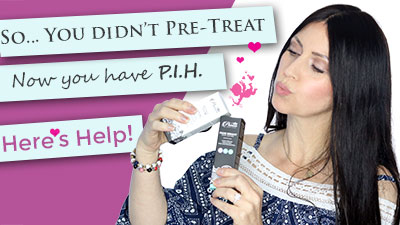
So, you didn't follow protocol and ended up with PIH... or maybe you had acne, and now you've got PIH. Regardless of how you got here, you're not alone. PIH is one of the top reasons why many people, especially those with ethnic skin, end up in a dermatologist's office. But fear not, there are steps you can take at home to address this issue effectively.
Understanding Post Inflammatory Hyperpigmentation (PIH)
First, what is PIH? PIH stands for Post Inflammatory Hyperpigmentation, a mouthful of a term for those annoying dark patches that appear on your skin after it's been through some form of injury or irritation. These pesky discolored areas typically show up in the same spot where you initially had inflammation. Common culprits include insect bites, dermatosis, burns, poorly pre-treated cosmetic procedures like peels, and of course, acne.
What Causes Post Inflammatory Hyperpigmentation (PIH)?
Post Inflammatory Hyperpigmentation, or PIH occurs due to an excess production of melanin or irregular pigment dispersion after an inflammation subsides. Think of a pimple—it swells, then darkens as the swelling goes down. That's PIH in action.
The color of the pigmentation depends on where it sits within the skin's layers. Superficial injuries in the epidermis tend to look brown and can take quite some time to fade if left untreated. Deeper pigmentation in the dermis can appear bluish-grey and is often permanent. Both types worsen with exposure to UV rays.
Who Gets Post Inflammatory Hyperpigmentation (PIH)?
While PIH can affect people of all skin types, it's more prevalent in those with medium to dark ethnic skin tones. Research has shown that melanin-rich skin is more reactive to minor skin traumas, making PIH a common occurrence.
A 2022 study has revealed that 65% of African Americans, 52% of Hispanics and 47% of Asian patients developed PIH after common inflammations such as acne.
Interestingly, within each racial group, individuals with darker skin tones are at higher risk. For example, a darker-skinned Indian will have a higher chance of getting PIH than a lighter-skinned Indian. Same with Asian and black skin types. Here at Platinum we talk on the phone to a large amount in the Indian and Asian communities dealing with PIH. So just because you don’t have the darkest skin tone – don’t think that puts you in the clear. It most certainly does NOT.
A great amount of people who are looking to do chemical peels will fall into this category, that is why it is SO important to properly pretreat your skin before applying any acid peel.
The prep that we recommend for ethnic skin types PRIOR to a peel is the exact same treatment that can be used to TREAT problematic PIH.
The Right Pre-Treatment for Ethnic Skin
So, how should an ethnic skin type pretreat? To prevent Post Inflammatory Hyperpigmentation (PIH) and prepare your ethnic skin for chemical peels, we recommend a three-product pre-treatment regimen:
-
Fade Bright Melanin Inhibitor
Apply this twice daily for a minimum of two weeks. It contains Alpha Arbutin, Kojic Acid, Azelaic Acid, Licorice Extract, Mulberry, Bearberry, Resveratrol, Niacinamide, and Lactic Acid—ingredients that work together to reduce melanin production in the skin. This prevents melanin buildup after skin injury. Continue using it immediately after the peel and daily to control pigmentation and brighten your skin. -
Retinol Molecular Serum
Apply this each evening on top of Fade Bright. Retinoids have anti-inflammatory properties and speed up cellular turnover, helping to lighten the skin. They complement melanin inhibitors for faster skin tone balancing. -
Broad-Spectrum SPF
Use a minimum SPF of 30, or SPF 50 if you already have PIH before your chemical peel. Concerns about vitamin D in darker skin are valid, but studies have shown that sunscreen users still maintain normal vitamin D levels. If needed, you can supplement your diet with 1000 IU of vitamin D through diet and supplementation.
There is always some concern with SPF’s and darker skin tones. It is true that vitamin D is important to those with darker skin – but clinical studies have shown that sunscreen users levels are still within normal range. *If you are truly at risk for a Vitamin D deficiency, you can always add a total dose of 1000 IU of D through diet and supplementation instead.
If your choice is to forego the SPF, just know that you will not be able to adequately treat your PIH and it will continue to worsen.
You can go further with your treatments than just our peel prep though. So let’s talk about other options to reduce or remove PIH.
How to treat Post Inflammatory Hyperpigmentation (PIH)?
To address Post Inflammatory Hyperpigmentation (PIH) effectively, it's crucial to tackle the inflammation that causes it. For bites, burns, or other injuries, simple remedies like cold compresses or over-the-counter pain relievers as aspirin or ibuprofen, can help reduce swelling.
After a chemical peel, rinsing the treated area with cold water is recommended to minimize inflammation and calm the skin.
Topical depigmenting agents can also be beneficial. These include hydroquinone (for short periods), Alpha Arbutin, Azelaic Acid, Kojic Acid, Licorice Extract, Niacinamide, Ascorbic Acid (Vitamin C), and retinoids. Apply these daily for continuous improvement. Notably, all these ingredients, except C and Hydroquinone, can be found in our Fade Bright formula – and that was NOT an accident. We created that formula with all of the most powerful agents to treat pigmentation that we could.
Unfortunately, for deeper pigmentation, when it does not respond well to any of these agents, professional assistance may be necessary.
Choosing the Right Chemical Peel for Post Inflammatory Hyperpigmentation (PIH)
Chemical peels are effective for treating PIH, but individuals with darker skin should be cautious about the choice of acids and their percentages. Opt for the following options:
- Salicylic acid at 15% or 25% every two weeks: It has anti-inflammatory properties and aids in reducing melanin buildup
- Jessner's peel at 2-4 layers once a month: Contains Salicylic acid, Lactic acid, and Resorcinol, which can be effective over 3-8 peels on average.
- TCA peel at 13% and 2-4 layers once a month: Suitable for those who have pre-treated their skin for at least 2 weeks before application.
Minor peels like Mandelic and Azelaic Peel (22%) and Lactic 50% can also be considered, with a series of 8 treatments recommended.
A good rule of thumb to see if you will be more prone to getting PIH after a chemical peel is to take a good look at your body. Do you have dark marks on your legs from bites or scrapes. Dark marks on your knuckles or knees? Spots on your face, neck or chest from old blemishes?
If so, then you will want to pretreat for 4 weeks or more prior to applying a peel. Here at Platinum we feel that it is always better to be safe than sorry. It is MUCH easier to prevent PIH than it is to treat it.
How to Prevent Post Inflammatory Hyperpigmentation (PIH)
If you're prone to PIH due to previous marks on your body, it's advisable to pretreat for at least 4 weeks before applying a peel. Remember, prevention is more manageable than treatment. Always go on the side of caution and gradually increase the strength of your peel.
You will most definitely find people out there who swear that you don’t need to pretreat your skin prior to a peel – even one such as a deeper TCA - … and maybe they escaped without any issues … but the odds are NOT in your favor – so always pretreat and work up in strength slowly.
If you have more questions or need guidance on treating PIH, feel free to explore our video on TCA Peels for Dark Skin or reach out to our team. We're here to assist you in achieving healthier, even-toned skin.
Final Thoughts
Post Inflammatory Hyperpigmentation can be challenging, but with proper pre-treatment, effective skincare, and the right chemical peel, you can take control of your skin's appearance. Whether you're looking to prevent PIH or seeking treatment options, knowledge, and caution are your allies on the path to clearer, more radiant skin.



